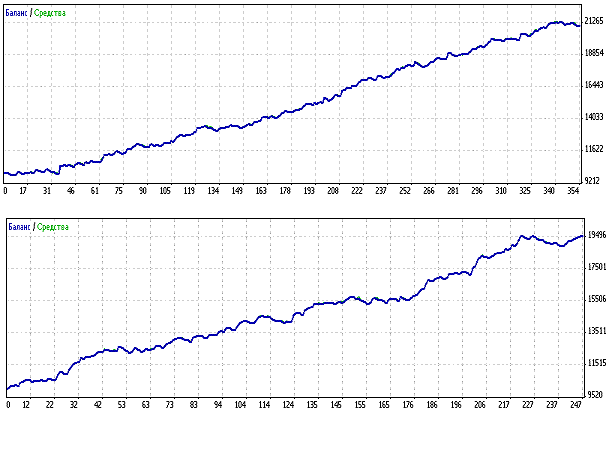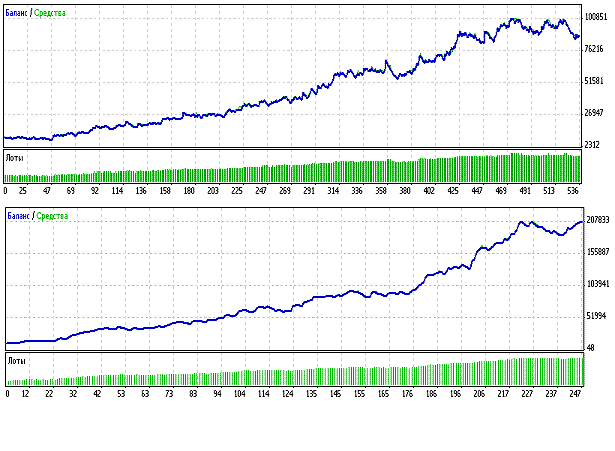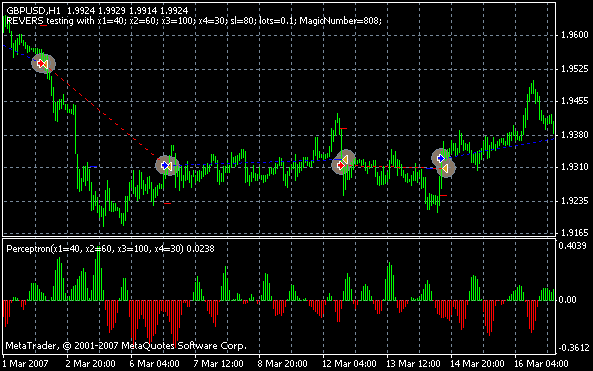Non-standard Automated Trading
Leonid Borsky | 24 July, 2007
Introduction
Successful and comfortable trading using MT4 platform without detailed market analysis - is it possible? Can such trading be implemented in practice?
I suppose, yes.
Especially in terms of the automated trading! MQL4 allow doing this. The further described automated trading system is characterized by good repeatability. And it can be easily implemented even by newbies, who are just starting to get acquainted with the basics of writing Expert Advisors.
The system itself is actually a reflection of the outworld. The harmoniously developing life dictates its laws. When children, we all observed the following scene: ants hold a straw from different sides and pull it into an ant-hill. And each ant pulls the straw its own way. Nevertheless, finally the stray is carried in the direction of the ant-hill! A secret of nature? Let us try to simulate the situation on a trading platform.
Non-standard Automated System
Suppose we have some automated trading system of a profit kind. The system meets the following requirements:
- Entry signals are practically random.
- The system is constantly in the market, i.e. it operates with counter-directed positions instead of stops - it is important.
- Using several static parameters, located at the entrance, we optimize the system, in order to get a maximal profit with a reasonable drawdown.
Practically this system will give annual profit +3000 points even without Money Management block. After that we enable this system in a reverse mode. In other words now it will operate the following way:
- If we were buying in a direct mode, now we will be selling and vice versa. After that we once again optimize the system using static parameters. And at the exit of the reverse version we get the maximal profit with reasonable drawdown. It should not cause any problems, because our automated trading system is originally built on random entries.
- After that we simultaneously start both versions - direct and reverse. The simultaneous operation of both versions is a very important, key moment of the described trading system!
Let us see what we have.
At a simultaneous start of both systems - direct and reverse, we make a double profit. However, the systems operate in counter modes, i.e. opposite each other, consciously, not blindly! Besides we have reduced total losses - current relative drawdown. And why do systems operate consciously, not blindly?
The reason is, that because of other static parameters, already in three-four trades after the start the reverse system will trade with some shift in time and price, as compared with the direct system. Still, the entrance algorithm in the reverse mode is the same.
But the total profit will progressively increase! I think it is obvious, while both systems - direct and reverse, are optimized for a profit operation. Moreover, current losses of one version will be almost always covered by the current profit of another version! Consequently we make the maximal profit and minimal drawdown.
Some disadvantage is the increasing of margin requirements. But can this fact be called a disadvantage? Actually here are two operating independent trading systems - direct and reverse. And, naturally, the margin requirement will be double. And as far as risks are concerned, they will be sufficiently reduced! This is the main idea - not to increase profit, but to maximally reduce drawdown. But one thing inflicts another. And, once again, the total profit in such a trading will progressively increase. Consequently, now we can enable the block Money Management.
The site MQL4.community contains a wide choice of different Expert Advisors, including those meeting the above listed requirements. The market itself makes us put new tasks and find different, non-standard solutions! We can also find possibilities for further search.
For the realization of the idea and further experiments, we used an Expert Advisor of Yury Reshetov "Artificial Intelligence" as a basis, described earlier in the same part (see the article by Y. Reshetov "How to Develop a Profitable Trading Strategy". It was used with some amendments and additions, in particular, it includes an option of calling another basic indicator for the operation of Perceptron. It has also some additional conditions for opening and further tracking of positions.
Here are some results of the experiment, gained during the testing of the pair GBPUSD on the timeframe H1. The start-up deposit is 10000 units. 2.5 year history - from January 2005 till May 2007.
The direct version contained 250 trades within this period. The reverse one - 360 trades. The number of trades differs, because the stoploss level during optimization was different for each version. The net profit in both cases is approximately +10000. During operation with 0.1-lot, not enabling the block Money Management, profitable and loss trades are in the ratio 3:2 in both versions.
Here are the examples of the balance/equity graphs of the direct and reverse versions on the history:

You can see, that in most cases losing trades of the direct version are hedged by profitable trades of the reverse version. And vice versa - losses of the reverse version are hedged by the profits of the direct version.
Moreover, where one chart contains flat, another one contains uptrend! Finally we get the maximal total profit with minimal risks, i.e. with minimal drawdown. It will not cause any problem to gather the history of all trades in Excel and draw a resulting chart, visualising the idea described.
The next step is enabling the block Money Management. We can expect, that enabling this block during such a trading will significantly improve the final results in terms of profit, drawdown and the convenience of trading. In the direct and reverse versions I included calling the library of lots' calculation "b-lots" after I. Kim. It is easily included into the source code and operates quite well: https://www.mql5.com/en/code/8048
During testing I used proportionate method of calculating lots ( LotsWayChoice=2 ), which gives a reasonable minimal drawdown with relatively good profits (Ryan Jones, "The Trading Game: Playing by the Numbers to Make Millions"). The results are quite good, as compared with other methods of calculating lots, which very often show large profits with large drawdown.
Let's view the same history, from January 2005 till May 2007. The results of testing with the same parameters, as earlier:
Reverse version:
- Net profit +79864
- Maximal drawdown 16969 (24%)
- Relative drawdown 33% (3511)
Direct version:
- Net profit +196520
- Maximal drawdown 25801 (12.3%)
- Relative drawdown 18.14% (6972)
Here are the balance charts:

These charts also very vividly display, how the current losses are covered by the reverse-version profits. I think, the convenience of such trading is evident.
Practical Use
As an example and for further primary experiments, here is a code of a reverse version, which works contrary to the direct version of the author's variant of the Expert Advisor "AI" by Y. Reshetov. A direct version and its description are located at: https://www.mql5.com/ru/code/10289
Beside this, the attached file contains the indicator Perceptron (the author - NoName from Ukraine, Kremenchug), which enables to control visually the current work of Expert Advisors (direct and reverse), and know beforehand, in which direction a new position will be opened. Here set the values of weight coefficients X1-X4 of the indicator Perceptron equal to the corresponding EA values. Here is an example of the reverse version:

For those, who only start working with MQL4, I tried to give maximum comments on the EA operation. The perceptron outputs of this reverse version's operation are displayed on the chart in the upper left corner:
//+------------------------------------------------------------------+ //| ArtificialIntelligenceRevers.mq4 | //| Copyright й 2006, Yury V. Reshetov | //| Modifed by Leonid553 | //| http://www.tradersforum.net.ru/ | //| | //+------------------------------------------------------------------+ #property copyright "Copyright й 2006, Yury V. Reshetov ICQ:282715499" #property link "http://reshetov.xnet.uz/" //---- input parameters extern int x1 = 88; extern int x2 = 172; extern int x3 = 39; extern int x4 = 172; // StopLoss level extern double sl = 50; extern double lots = 0.1; extern int MagicNumber = 808; static int prevtime = 0; static int spread = 3; //+------------------------------------------------------------------+ //| expert initialization function | //+------------------------------------------------------------------+ int init() { //---- return(0); } //+------------------------------------------------------------------+ //| expert deinitialization function | //+------------------------------------------------------------------+ int deinit() { //---- return(0); } //+------------------------------------------------------------------+ //| expert start function | //+------------------------------------------------------------------+ int start() { Comment(perceptron()); // Wait for the formation of a new candlestick // If a new candlestick appears, check for the possibility of a trade if(Time[0] == prevtime) return(0); prevtime = Time[0]; //---- if(IsTradeAllowed()) { spread = MarketInfo(Symbol(), MODE_SPREAD); } else { prevtime = Time[1]; return(0); } int ticket = -1; // check for opened position int total = OrdersTotal(); for(int i = 0; i < total; i++) { OrderSelect(i, SELECT_BY_POS, MODE_TRADES); // check for symbol & magic number if(OrderSymbol() == Symbol() && OrderMagicNumber() == MagicNumber) { int prevticket = OrderTicket(); // long position is opened if(OrderType() == OP_BUY) // if a long position is opened and ... { // check profit // the current profit is larger than the value of =(stoploss + spread) and ... if(Bid > (OrderStopLoss() + (sl * 2 + spread) * Point)) { if(perceptron() > 0) { // perceptron is more than zero, then turn to Sell // reverse ticket = OrderSend(Symbol(), OP_SELL, lots * 2, Bid, 3, Ask + sl * Point, 0, "AI", MagicNumber, 0, Red); Sleep(30000); if(ticket < 0) { prevtime = Time[1]; } else { OrderCloseBy(ticket, prevticket, Blue); } } else //if perceptron is less than zero, trail the stoploss to the distance =sl //from the current price { // trailing stop if(!OrderModify(OrderTicket(), OrderOpenPrice(), Bid - sl * Point, 0, 0, Blue)) { Sleep(30000); prevtime = Time[1]; } } } // short position is opened } else { // if a short position is opened and ... // check profit if(Ask < (OrderStopLoss() - (sl * 2 + spread) * Point)) { // the current profit is larger than the value of =(stoploss + spread) and ... if(perceptron() < 0) { // perceptron is less than zero, then turn to Buy // reverse ticket = OrderSend(Symbol(), OP_BUY, lots * 2, Ask, 3, Bid - sl * Point, 0, "AI", MagicNumber, 0, Blue); Sleep(30000); if(ticket < 0) { prevtime = Time[1]; } else { OrderCloseBy(ticket, prevticket, Blue); } } else //if perceptron is more than zero, trail the stoploss to the distance =sl //from the current price { // trailing stop if(!OrderModify(OrderTicket(), OrderOpenPrice(), Ask + sl * Point, 0, 0, Blue)) { Sleep(30000); prevtime = Time[1]; } } } } // exit return(0); } } //******************************************************************** // check for long or short position possibility // initial entrance to the market: if(perceptron() < 0) { // if the perceptron is less than zero, open a long position : // long ticket = OrderSend(Symbol(), OP_BUY, lots, Ask, 3, Bid - sl * Point, 0, "AI", MagicNumber, 0, Blue); if(ticket < 0) { Sleep(30000); prevtime = Time[1]; } } else // if the perceptron is more than zero, open a short position: { // short ticket = OrderSend(Symbol(), OP_SELL, lots, Bid, 3, Ask + sl * Point, 0, "AI", MagicNumber, 0, Red); if(ticket < 0) { Sleep(30000); prevtime = Time[1]; } } //--- exit return(0); } //+------------------------------------------------------------------+ //| The PERCEPRRON - a perceiving and recognizing function | //+------------------------------------------------------------------+ double perceptron() { double w1 = x1 - 100.0; double w2 = x2 - 100.0; double w3 = x3 - 100.0; double w4 = x4 - 100.0; double a1 = iAC(Symbol(), 0, 0); double a2 = iAC(Symbol(), 0, 7); double a3 = iAC(Symbol(), 0, 14); double a4 = iAC(Symbol(), 0, 21); return (w1 * a1 + w2 * a2 + w3 * a3 + w4 * a4); } //+------------------------------------------------------------------+}
It should be noted, though, that the main meaning of the described trading tactic is not in this particular Expert Advisor. But on the contrary, it is in the cooperation of the direct and reverse versions of any proper Expert Advisor, as explained in the beginning of the article. And here are different variants possible: you can have several reverse versions - created and optimized upon different criteria, in accordance with the initial algorithm of the direct version. The choice here is quite wide.
Working further on this idea, I would offer drawing support and resistance lines. Or attach the MA indicator or any other proper indicator to the balance chart. In this case, upon the indicator signals we could to some extent handle the prohibition of trades on each version. I think it is programmable.
But it is in prospect.
Conclusion
A can presuppose the objections of sceptics - and what if both versions start working at a loss?
Well, this may happen in rear, exceptional cases. But no more than that - "nothing is ideal in this world". However, at practically accidental entries, both versions work on the signals of one indicator and in counter directions - one against the other!
Combining both versions into one Expert Advisor, we get an efficient tool for further management of a portfolio trading. And for further experiments.